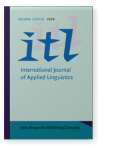Vol. 125/126 (1999) ► pp.253–275
Vol. 125/126 (1999) ► pp.253–275
Some aspects of repair in native and non-native speaker conversations in English
The ability to carry out repairs is a key skill in spoken discourse for non-native speakers of English and has been widely studied. However, VAN HEST et al. (1997) have suggested that investigations into repair in L2 need to be more theoretically driven and less concerned with individual differences. Drawing on information from a pilot study of twenty-three conversations, lasting 185 minutes between six native and six non-native speakers, this paper argues that there is no conflict between a concern with individual differences and theory building. What is needed is a contextualised theory which is grounded in particular situations and individual differences. The paper identifies three possible areas of difficulty that may arise if a theory is not contextualised. Firstly, the paper argues that theory driven research encourages methods of data collection that we characterise as experimental and suggest that these need to be supplemented by more naturalistic forms of data collection. Secondly, the paper criticises the view that there are general preferences as to who initiates and who completes repairs and argues that a contextualised theory of repair would capture initiation/completion patterns more adequately. Finally, the paper argues that the distinction between native and non-native speakers needs to be re-examined. This is supported by the finding in the pilot study that there was little variation between native and non-native speakers in terms of these analyses.
